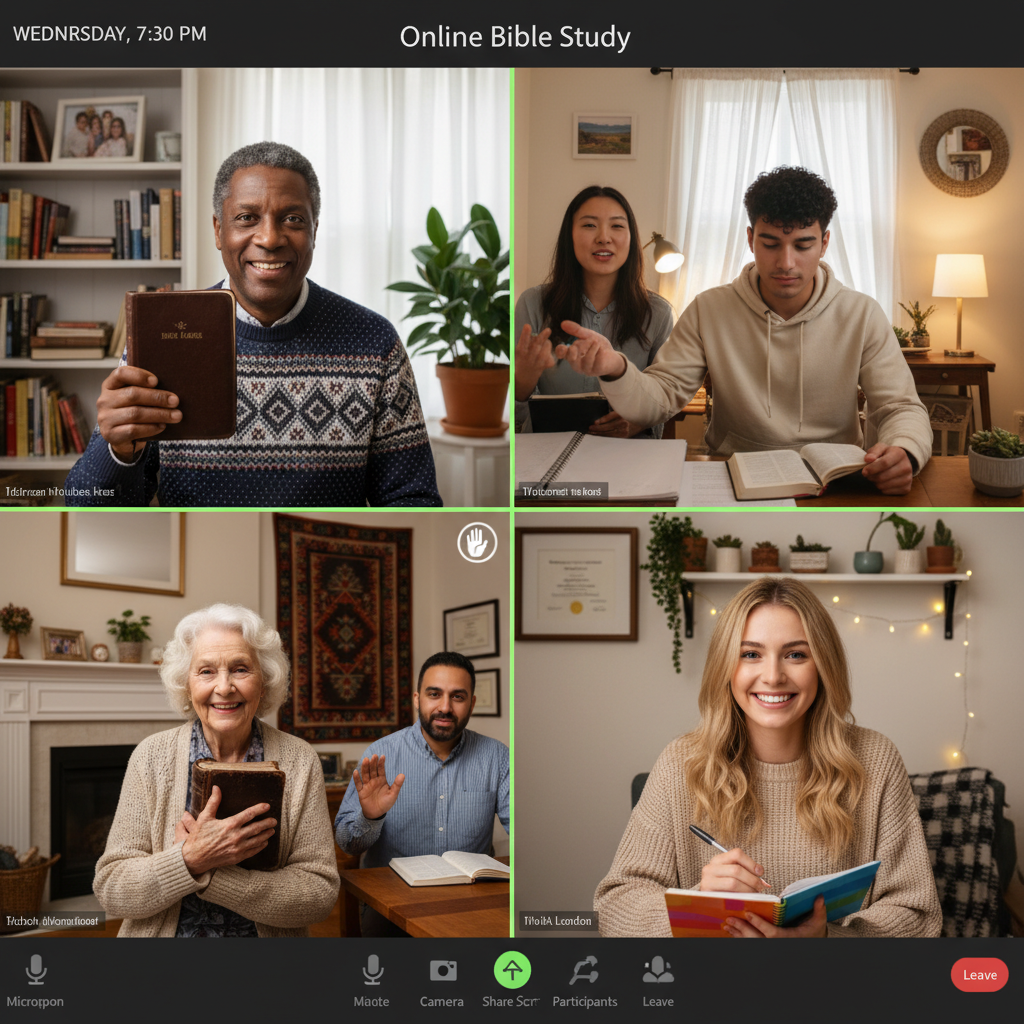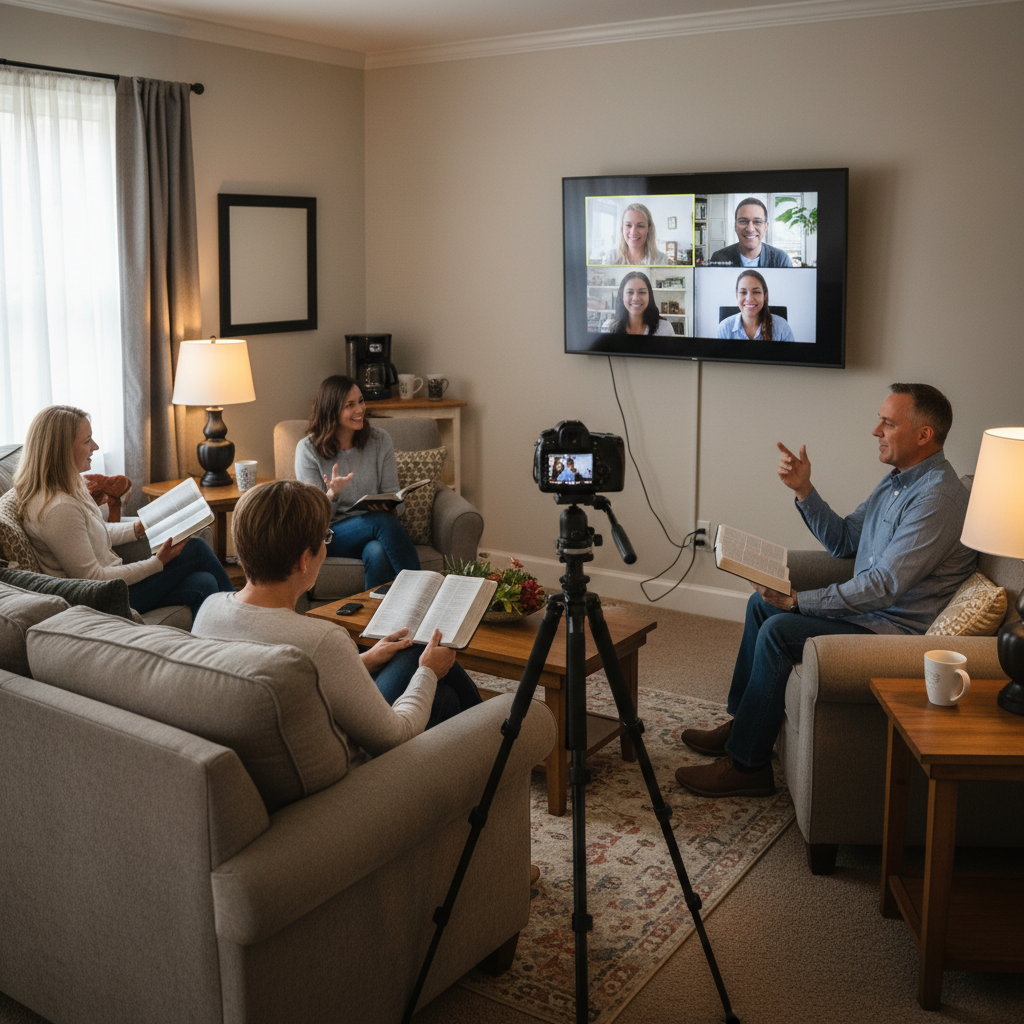Picture this: It's Wednesday evening, 7:47 PM. Sarah, a nurse in Seattle, logs into her Bible study group during her night shift break. At the same moment, Marcus in Nairobi is waking up to his 6:47 AM Thursday devotional, coffee in hand. Elena in Madrid is settling in after putting her kids to bed at 1:47 AM her time. Three continents, three wildly different lives, one illuminated screen showing the same passage from Romans. They wave at each other through their laptop cameras, and for the next hour, geographic boundaries dissolve entirely.
This isn't science fiction. This is online Bible study in 2025, and it's revolutionizing how millions of believers engage with Scripture. What started as an emergency pivot during a global pandemic has evolved into something far more profound than anyone expected. The question isn't whether online Bible study works anymore. The question is whether we can even imagine going back to a world where your spiritual growth is limited by your ZIP code.
But let's rewind for a moment, because the story of how we got here is more fascinating than you might think.
From Correspondence Courses to Zoom Rooms: A Brief History
Online Bible study didn't begin with the internet. Its spiritual ancestor was the correspondence course, those thick manila envelopes arriving in rural mailboxes throughout the 1950s and 60s. If you lived too far from a church or seminary, you could still study systematic theology by mail. Moody Bible Institute pioneered this approach in 1901, mailing lessons to students worldwide. You'd read, complete written assignments, mail them back, and wait weeks for feedback. It was slow, solitary, but better than nothing.
The 1980s brought a modest upgrade: video cassette Bible studies. Beth Moore, Kay Arthur, and others recorded teachings you could watch in your living room, pausing to take notes. You weren't alone anymore, exactly, but you were watching a one-way broadcast. The teacher couldn't see you, answer your specific questions, or know your name.
Then came the early internet era. In 1996, BibleGateway launched, offering searchable Scripture online. By the early 2000s, forums and chat rooms appeared where Christians could discuss theology. These were text-based, often anonymous, sometimes chaotic. You might be debating eschatology with someone whose profile picture was a cartoon character. The technology existed, but nobody had quite figured out how to replicate the warmth of in-person community through a screen.
The breakthrough came quietly, around 2013-2015, when video conferencing became reliable and accessible. Suddenly, you weren't typing at strangers. You were looking into the eyes of real people, seeing their bookshelves and family photos in the background, hearing the authenticity in their voices when they shared prayer requests. Technology had finally caught up to what our hearts needed: genuine connection.

March 2020: The Great Acceleration
And then everything changed in a matter of weeks.
When COVID-19 lockdowns began in March 2020, churches worldwide faced an impossible choice: cease all Bible studies or figure out this "online thing" immediately. Pastors who had never used Zoom were hosting virtual small groups by the following Tuesday. Grandmothers who barely understood email were clicking join links to stay connected with their prayer circles.
The first few weeks were chaotic. People forgot to unmute. Cats walked across keyboards. Someone's teenage son would wander through the background in pajamas. But something unexpected happened amid the technical difficulties: people kept showing up. In fact, more people showed up than had attended in person.
Pastor Michael Chen in Austin, Texas, watched his Tuesday night Bible study attendance triple. "We suddenly had young parents who couldn't get babysitters before, night shift workers who were awake but couldn't drive across town at 7 PM, and folks with mobility issues who found stairs a barrier," he told Christianity Today in 2021. "One woman had attended our church for 15 years but never joined a small group because she had severe social anxiety. Online, she found the courage to turn on her camera and participate."
This pattern repeated globally. A study by the Barna Group found that 32% of Christians who never attended Bible study before the pandemic joined online groups during lockdowns, and remarkably, 67% of them were still participating two years later. The pandemic forced an experiment, and the results surprised everyone.
What the Research Actually Shows
For years, the assumption was obvious: online study could never match in-person community. How could it? You can't hug someone through a screen. You can't share a meal or pass the tissue box when someone tears up. The research, however, tells a more nuanced story.
The American Bible Society's 2022 "State of the Bible" report delivered surprising findings. Participants in structured online Bible studies showed 40% higher completion rates compared to traditional in-person studies. Even more striking, verse retention - measured through follow-up quizzes - was 33% better in online groups. The researchers initially questioned their own data. How could this be?
The answer, they discovered, lies in how people engage with online content. When you're in a physical room, social pressure might keep you nodding along even if you're confused. Online, participants feel more comfortable using the chat function to ask clarifying questions. They can quickly look up a cross-reference without disrupting the flow. They take more notes because they're already at their computer. And here's the crucial factor: they pause and rewind video teachings, reviewing difficult concepts multiple times.
Dr. Sarah Coakley, a theologian at Cambridge University, has studied online spiritual formation extensively. "What we're seeing challenges our assumptions about embodied community," she explains. "The digital space creates what I call 'liberating distance' - enough separation to be vulnerable, close enough to be authentic. Participants in online groups often share more deeply, more quickly, because the slight buffer of the screen actually reduces anxiety rather than increasing it."
This doesn't mean online is universally better. The research also shows limitations: online groups struggle with conflict resolution, non-verbal cues are harder to read, and the temptation to multitask during sessions is real. But the data demolishes the notion that pixels can't produce genuine spiritual growth.

Three Formats, Infinite Possibilities
Not all online Bible study looks the same. The format you choose shapes your experience profoundly, and understanding the options helps you find what fits your life.
Synchronous: The Live Experience
Synchronous study means everyone logs in at the same time, like a traditional class moved online. You see faces, hear voices, interact in real-time. This format works beautifully for people who thrive on scheduled commitments and immediate feedback. The accountability is built-in: you know your small group expects you on Thursday nights at 8 PM, so you show up.
The magic of synchronous study is spontaneity. Someone asks a question you hadn't considered. A conversation takes an unexpected turn when another participant shares how a verse spoke to their current crisis. You can't script these moments. Jennifer, a member of a live online study group, describes it this way: "Last Tuesday, we were discussing forgiveness in Matthew 18. Maria started crying, sharing about her estranged daughter. We prayed for her right then, all unmuting at once to say 'amen' together. That can't happen in a forum post."
The limitation? Synchronous study requires coordination. Finding a time when everyone across different time zones and work schedules can meet becomes complicated. Miss a week, and you might feel behind. But for those who can commit to the schedule, the relational depth often exceeds even in-person groups.
Asynchronous: Study on Your Clock
Asynchronous study is the choose-your-own-adventure version. Watch the video teaching at 6 AM before work or at 11 PM after everyone's asleep. Read the discussion prompts during your lunch break. Post your reflection when inspiration strikes at 2 AM. No schedules to coordinate, no pressure to perform, just you and Scripture on your timeline.
This format particularly serves shift workers, parents of young children, international students, and anyone whose schedule defies traditional meeting times. Marcus works as a flight attendant, living in airports and hotel rooms. "Asynchronous study saved my spiritual life," he says. "I'd be in Dubai on Tuesday, home in Toronto on Friday, then off to Mexico City on Sunday. I could never commit to a 7 PM anything. But I could watch that week's teaching video on a layover, type my thoughts in the discussion forum before takeoff, and read others' responses when I landed."
The trade-off is immediacy. You post something vulnerable, then wait hours or days for responses. The conversation unfolds slowly, like an epistolary novel. Some people find this deeply meditative - time to think before speaking, space to process others' words carefully. Others find it isolating, missing the energy of real-time exchange.
Hybrid: The Best of Both Worlds
Hybrid models combine synchronous and asynchronous elements, and they're increasingly popular because they accommodate different learning styles and life situations within the same group. A typical hybrid approach might include a weekly live video session plus daily discussion forums.
Here's how it often works: Sunday through Friday, members watch short daily video devotionals (5-10 minutes) and post reflections in a shared forum. Saturday morning, the group meets live on video for an hour to discuss the week's themes, pray together, and build relationship. If you miss the live session, it's recorded, but the daily engagement keeps everyone connected throughout the week.
The genius of hybrid is flexibility without losing community. You get deep relationship through live sessions while accommodating busy schedules through asynchronous content. It's the model most likely to sustain long-term participation because it bends without breaking when life gets complicated.

Stories from the Digital Frontier
The statistics tell part of the story. The human experiences tell the rest.
Take Robert, a rancher in rural Montana. His nearest church is 47 miles away over mountain roads that become impassable in winter. For decades, his spiritual life consisted of Sunday morning services when weather permitted and solitary devotions the rest of the time. Then his daughter set him up with a tablet and showed him how to join an online men's Bible study.
"I thought it would be weird, talking to a screen," Robert admits. "But by the third meeting, I forgot we weren't in the same room. These guys know my cows by name. They prayed me through losing my best dog last spring. And here's the thing: I've learned more theology in the past year than in 30 years of Sunday sermons, because we actually discuss things, work through questions together."
Or consider Yuki in Tokyo, who works a brutal corporate job where admitting Christian faith could hurt her career. She found an international online study group that meets during her Tuesday lunch break. "In Japan, being Christian is isolating," she explains. "My church has maybe 30 members, mostly elderly. Online, I'm part of a vibrant community of young professional women from Lagos to London to Lima. We share how to live out faith in secular workplaces. I don't feel alone anymore."
Then there's the story that made headlines: a Bible study group that formed in March 2020 when eight strangers from four continents joined a "Beginners Welcome" online study. Five years later, they're still meeting every Wednesday. Two members have visited each other in person. They sent flowers when one member's father died. They celebrated via video call when another had a baby. One member jokes that her online Bible study friends know her better than her cousins.
These aren't rare exceptions. They're increasingly normal. Fuller Theological Seminary's research on online faith communities found that groups meeting consistently for six months or longer report relationship satisfaction rates statistically identical to in-person groups. The medium matters less than the consistency and vulnerability.
The Technology Barrier Is (Mostly) a Myth
"I'm not tech-savvy enough for online Bible study." This is the most common objection, and it's based on an outdated reality. In 2015, maybe you needed to be comfortable with complex software. In 2025, you need to be able to click a link.
Most online Bible study platforms now offer what's called "one-click join." You receive an email or text with a blue link. You click it. You're in. No account creation, no password to remember, no software to download. Your group leader sees your video, you see theirs. That's it.
But what about older adults who genuinely struggle with technology? This is where community becomes crucial. Churches offering online studies often provide "tech buddy" programs where younger members help seniors through initial setup. One Methodist church in Florida runs monthly "Tech & Testimony" sessions where anyone can bring devices and get help troubleshooting before that week's Bible study.
Martha, 78, was convinced she'd never manage online study. Her grandson spent 20 minutes showing her how to click the Zoom link on her iPad. "The third week, I figured out how to change my background to a pretty beach scene," she laughs. "Now I'm the one teaching my friends. Last month, I joined a second study group on church history. Technology isn't the barrier we think it is - it's just unfamiliar until it isn't."
The real requirements are minimal: internet connection (3 Mbps is enough for video), any device with a screen and audio (smartphone, tablet, laptop, desktop), and willingness to click a link. Everything else is optional. Don't have a camera? Many people participate audio-only. Spotty internet? Audio remains stable even when video cuts out. Limited data? Many platforms offer low-bandwidth modes.

Zoom Fatigue vs. Spiritual Hunger
By late 2020, a new phrase entered the cultural vocabulary: Zoom fatigue. After eight hours of work video calls, the last thing most people wanted was another screen session, even for Bible study. Microsoft Research published findings showing that back-to-back video meetings increase stress hormones and decrease focus.
So why didn't online Bible study suffer the same fate as work meetings? The answer reveals something important about what makes virtual community work.
First, spiritual community feels different because it is different. You're not performing for a boss or meeting a deadline. You're connecting over shared values and ultimate concerns. Dr. Jeremy Nobel, who directs Harvard's Project UnLonely, explains: "Not all screen time is equivalent. Transactional interactions - work meetings, customer service calls - drain energy. Relational interactions around meaning and purpose can energize, even through screens."
Second, effective online Bible study groups learned to structure differently than work meetings. Keep sessions shorter - 45 to 60 minutes instead of the traditional 90-minute small group. Build in pauses and silence for reflection. Allow "camera off" options for people who need a break from being watched. Use breakout rooms for smaller conversations within the larger group. These adjustments honor human limits while maintaining connection.
Third, many groups shifted to hybrid models that reduce live screen time. Instead of a 90-minute weekly video call, they do 30 minutes live plus daily asynchronous discussion. The live portion becomes a highlight rather than a burden, like gathering with friends rather than attending another meeting.
Interestingly, research by the Barna Group found that people's reported "Zoom fatigue" from online Bible study decreased over time rather than increasing. The initial novelty wore off, but instead of boredom setting in, comfort and depth grew. Three months in, people were still excited to log on. Six months in, they actively looked forward to it. A year in, many described their online study as the highlight of their week.
The difference? Purpose and belonging trump format. If you're gathering to check boxes or exchange information, screens amplify fatigue. If you're gathering to wrestle with ancient texts and modern struggles alongside people who know your name and care about your life, screens become portals rather than barriers.
The Unexpected Global Church
Something remarkable happens when geography stops limiting fellowship: you discover how big and diverse the Body of Christ actually is.
Emma, a Presbyterian in Oregon, joined an online study on the Psalms. Her group included a Pentecostal pastor from Kenya, a Catholic nun from Ireland, a Baptist seminary student from South Korea, and a house church leader from China. "Our first meeting was awkward," Emma admits. "We came from such different traditions. But by week three, we were learning from each other's perspectives. The Kenyan pastor taught us about lament in African spirituality. The Catholic sister explained the monastic practice of Lectio Divina. The Chinese leader showed us how the Psalms speak to persecuted churches. My understanding of Scripture expanded exponentially."
This cross-pollination of traditions and cultures is one of online study's most significant gifts. Your local church might be predominantly one ethnicity, denomination, or socioeconomic class. Online, you can study alongside believers whose life experiences and theological perspectives differ radically from yours. Done with humility and respect, this diversity enriches everyone.
It also builds a more accurate picture of global Christianity. In the American church, it's easy to forget that most Christians worldwide are not white, not Western, and not wealthy. Online groups naturally reflect Christianity's true demographics. You realize your interpretation of Scripture isn't the only faithful one. You discover blind spots in your theology. You gain prayer partners whose concerns expand your intercession beyond your immediate context.
The global connections also create unexpected practical support. When severe flooding hit Kenya in 2023, Emma's Bible study group raised emergency funds within 24 hours. When the Chinese house church leader faced increased persecution, the group organized a prayer vigil across time zones, ensuring someone was praying every hour for 72 straight hours. When Emma's father was diagnosed with cancer, these people she'd never met in person became her primary prayer support.
"I used to think the 'global church' was an abstract concept," Emma reflects. "Now I know Joseph's morning commute problems in Nairobi, and he knows about my daughter's college applications. That's not abstract. That's family."

What Makes Online Bible Study Actually Work
After five years of rapid growth and millions of participants, we now have enough data to identify what separates thriving online Bible study communities from ghost town Zoom rooms. It's not about having the fanciest technology or the most charismatic teacher. It's about surprisingly simple principles consistently applied.
Consistency Trumps Everything
Online groups that meet at the same time every week sustain far better than those with flexible scheduling. Your brain needs to know: Tuesday at 7 PM is Bible study time. That predictability creates habit, and habit creates discipline, and discipline creates depth. Groups that say "let's figure out when everyone can meet this week" typically dissolve within three months.
Small Groups Stay Strong
The sweet spot for online Bible study is 5-10 people. Smaller than that, and one or two absences kill momentum. Larger than that, and quieter members disappear into observer mode. In person, you can manage larger groups because physical presence maintains connection. Online, you need active participation to feel engaged, and that requires manageable size.
Real Names and Real Faces
Anonymous online Bible study rarely works. Community requires knowing who you're talking to. Groups with highest retention require cameras on (with grace for occasional technical issues) and real names displayed. There's a reason Jesus called disciples by name and could see their faces. That personal recognition is not negotiable for genuine fellowship.
Beyond the Meeting
The most vibrant online communities don't limit interaction to scheduled sessions. They use group chats for prayer requests, shared funny memes about Christian life, birthday celebrations, and casual check-ins. The official study might be weekly, but connection happens daily. That ongoing thread transforms a meeting into a community.
Intentional Onboarding
Successful groups don't just drop new members into the deep end. They assign a "buddy" to help with tech setup, explain inside jokes, and make introductions. They reserve time in early meetings for extended personal sharing so newcomers aren't lost in established relationships. They remember that what feels comfortable to the core group might feel intimidating to someone clicking in for the first time.
The Future Is Already Here
Where is online Bible study headed? The technology will certainly evolve. Virtual reality Bible study rooms already exist in beta, though they feel gimmicky for now. AI teaching assistants can answer factual questions about historical context or translation nuances, freeing human leaders to focus on application and pastoral care. Automatic transcription and translation mean language barriers are falling.
But the technology matters less than the hunger driving adoption. People are spiritually starving for genuine community and deep engagement with Scripture. They're exhausted by superficial Sunday morning encounters that never move beyond "How are you?" "Fine, you?" They're isolated by geography, work schedules, life circumstances, or personality. Online Bible study offers a solution that's accessible, flexible, and surprisingly intimate.
The future of Bible study isn't online or in-person. It's both-and. Your church might offer Sunday morning groups in the building and Thursday night groups on video. You might do intensive in-person studies twice a year supplemented by weekly online connection. You might study primarily online but gather in person annually with your digital community for a retreat.
What we're learning is that the medium isn't the message. The message is still the Word of God, and the community is still the Body of Christ. The screens are just tools. Sometimes those tools enable what was never possible before: a rancher in Montana studying alongside a businesswoman in Tokyo and a refugee in Berlin, all opening the same Scripture, all encountering the same Spirit, all growing in the same faith.
That's not a substitute for in-person community. That's an expansion of it. And perhaps that's exactly what the global, diverse, scattered, unified, imperfect, beloved Church needs for such a time as this.